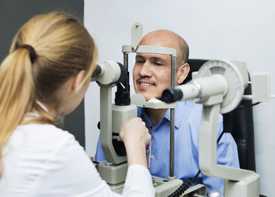Our Vision: Regular, Affordable Eye Exams
Can you guess what the biggest health fear is for many Americans? According to a recent nationwide poll, it’s blindness. People are so scared of losing their vision that many would rather lose their memory, their speech, even an arm or leg. That’s being afraid, being VERY afraid. The good news: regular vision care can help stop that fear from becoming a reality.
 Losing Sight of the Big Picture
Losing Sight of the Big Picture
Troubling but true: Due to our aging population, the number of people in the United States who are blind or visually impaired is estimated to double by 2030 . Raising awareness about vision health could help millions of Americans see better days ahead.
Awareness
As many as 45% of US adults haven’t had a dilated eye exam in the last 2 years. But regular eye exams can serve as the first line of defense against permanent vision loss. Eye diseases often develop without symptoms at first, and an eye exam can spot problems early when they’re most treatable.
Eye exams at every age and life stage can help keep vision strong. Staying on schedule is even more important for people at higher risk for eye diseases, including:
- People with diabetes —get an eye exam every year.
- People who are at higher risk for
glaucoma
—get an eye exam every 2 years:
- African Americans aged 40 years and older
- Everyone older than age 60, especially Mexican Americans
- People with a family history of glaucoma
Be sure to check with your health care provider about how often you should have an eye exam.
Cost
Many people with vision problems don’t get eye exams because they can’t afford them or lack vision insurance, which is a separate policy from health insurance coverage. However, there are no-cost or low-cost options available, especially for older people or those at higher risk for eye diseases. A few resources to get you started:
- The National Eye Institute can connect you with a variety of vision health resources that provide financial help.
- Prevent Blindness provides a list of organizations offering financial assistance for vision care services.
- Medicare Part B (health insurance) covers 80% of the yearly eye exam cost for people with diabetic retinopathy [PDF - 327 KB] as well as people at risk for glaucoma or macular degeneration .
Help for Low Vision
Low vision is loss of eyesight that can’t be corrected through surgery, medicine, or glasses/contact lenses. It’s caused by eye injuries or eye diseases and can make everyday activities like reading, writing, shopping, and driving—even recognizing faces—challenging. Living Well with Low Vision offers a self-help guide and a wealth of other resources, including links to support services and financial assistance programs. The American Foundation for the Blind also offers a directory of low vision service providers by state.
Look on the Bright Side
Everyone can benefit from regular vision care, from small children to seniors. And with regular eye exams, people at risk for eye diseases have the best chance to prevent or delay vision loss and enjoy a clearer, brighter future.
Find Out More
CDC's Division of Diabetes Translation
Vision Health Initiative
Keep an Eye on Your Vision Health
Learn About Age-Related Macular Degeneration
Vision Health Initiative (VHI) Resources
Diabetes Features & Spotlights
CDC Diabetes on Facebook
@CDCDiabetes on Twitter
- Page last reviewed: October 11, 2016
- Page last updated: October 11, 2016
- Content source:
- Maintained By:
- National Center for Chronic Disease Prevention and Health Promotion, Division of Diabetes Translation


 ShareCompartir
ShareCompartir